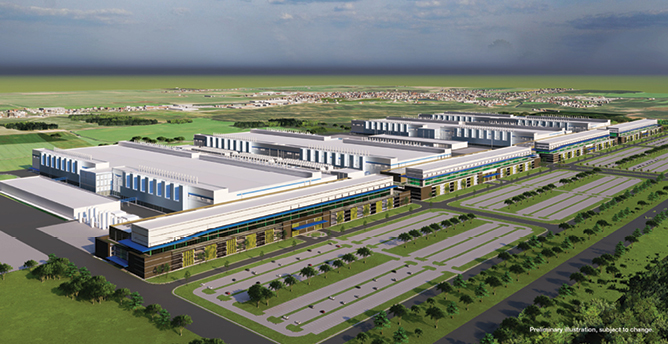With the cost of child care rising rapidly, the more than 14 million working parents in America with children under the age of three are faced with quite the conundrum: Shell out thousands of dollars a year on child care or leave the workforce to look after their children. Yet many can’t afford either option.
A report released by the Annie E. Casey Foundation in June 2023 found that the average cost of child care for one kid in 2021 was $10,600 a year, one-tenth of a married couple’s median income or more than one-third of a single parent’s income. It also revealed that approximately 13% of children below the age of five live in families where someone had to quit, change or refuse a job because of problems with child care.
As the when the nation is already experiencing labor shortages, it cannot afford to drive more parents out of the workforce due to a lack of affordable child care options. And with the emergence of the semiconductor industry expected to create hundreds of thousands of jobs over the next decade, ensuring the availability of this resource will be essential to its success.
Therefore the Department of Commerce has required that companies looking to access more than $150 million from the CHIPS and Science Act submit a proposal outlining how they plan to provide affordable child care for their workers. This includes facility employees and those hired for construction.
To receive funding, a company’s plan must demonstrate an understanding of the child care resources available in the project’s location. In many regions there aren’t enough child care workers, facilities or room for additional students. Availability is also limited for families who have infants and toddlers, have low incomes, work nontraditional hours or live in rural areas.
Affordability is another factor that must be considered. ReadyNation reports that the average cost of center-based child care for infants is more than in-state public college tuition in 34 states and the District of Columbia. In some areas, care for a single child can cost as much as 14-18% of a construction worker’s gross wages, according to the Department of Commerce.
“We’re not doing this for the sake of putting points on the board for child care policy, but we are acknowledging that when you look at the labor market right now, one of the largest factors keeping people out of the labor market is caregiving responsibilities,” Caitlin Legacki, a senior adviser at the Commerce Department, told Axios in February 2023.
Micron’s New Fabs Will Feature Child Care
In alignment with this contingency, Micron Technology, Inc., one of the largest semiconductor companies in the world and an applicant for CHIPS funding, has decided to build child care facilities at two of its current projects.
In Boise, Idaho, the company is constructing a “world class” childcare center directly across from its corporate headquarters and future memory manufacturing fab, a $15 billion investment that is expected to create 2,000 jobs.
Once completed, the new child care facility will offer STEM-based programming and will be operated by the Treasure Valley Family YMCA. To further address the needs of its Idaho employees and construction workforce, Micron is partnering with IdahoSTARS and other childcare referral tools to identify shared resources that support affordable and high-quality childcare.
“We recognize that there are systemic barriers to workforce entry and re-entry, including childcare services, which is why we are focused on providing childcare options that support and expand the workforce, and benefits the broader community.” said Micron Senior Vice President, Chief People Officer and President of the Micron Foundation April Arnzen in May.
Micron aims to create similar resources for the 9,000 employees it expects to hire once its semiconductor manufacturing campus in Clay, New York is also completed. As part of the agreement between Micron and New York State, the $100 billion project will include an onsite daycare center.
Since the company announced this multi-billion-dollar project, it has made several investments in the region’s childcare and education resources, including a pledge of $500,000 to the YMCA of Central New York to expand access to affordable and quality child care services for underserved communities.

Micron’s $100 billion semiconductor manufacturing campus in Clay, New York will feature an onsite child care facility.
Rendering courtesy of Micron
One State’s Approach to Incentivizing Accessible Care
Over the last four years, New York State has invested more than $7 billion in affordable child care, the state’s child care workforce and support for working families.
Through strategic incentives such as the Child Care Creation and Expansion Tax Credit, New York officials strive to increase the number of companies in the state that provide child care for their employees. Launched in December, this program offers businesses tax credits for eligible businesses that that create or expand affordable and accessible infant and toddler child care seats for their employees directly or through a third-party. $50 million has been set aside for this incentive and will be dispersed evenly over a two-year period.
This state has also allocated another $50 million to Child Care Capital Program (CCCP), which will award grants ranging from $500,000 to $1.5 million to eligible child care providers to expand existing child care centers or build new ones. Projects must be shovel-ready and demonstrate the ability to be licensed and fully operational within six months of completing construction and worth at least $500,000.
Both initiatives will be over een by the New York State Office of Children and Family Services (OCFS) and administered by the Dormitory Authority of the State of New York (DASNY).
“We have heard our hardworking families loud and clear, and are answering their call to increase high-quality options for child care and the much-needed resources to obtain it,” said OCFS Acting Commissioner and Child Care Availability Task Force Co-Chair Suzanne Miles-Gustave. “OCFS continues to work alongside the governor and the legislature to explore additional creative strategies to meet the growing demand for these services, knowing they are essential to the well-being of our children and families, and the growth of New York’s economy.”

